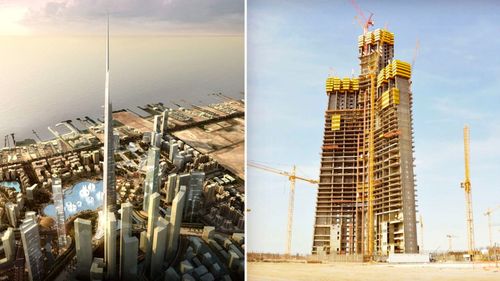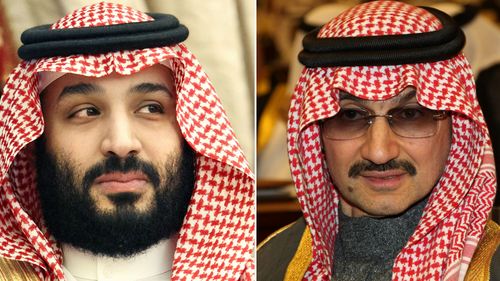Many of the world’s most iconic structures come with unusual stories.
French intellectuals and artists at first hated the “monstrous” Eiffel Tower; the British hid the Taj Mahal under bamboo scaffolding to stop it being bombed by the Luftwaffe during World War II; and it took a big leap of faith for the Golden Gate Bridge to be painted its now iconic, but then unorthodox, burnt orange.
If Saudi Arabia’s proposed one-kilometre-high Jeddah Tower ever gets finished, architectural historians will also have a rich storybook to dig into.

READ MORE: Transgender athletes banned from track and field
But, right now, that seems a big if.
Announced in 2008 by Saudi billionaire Prince Alwaleed bin Talal, construction of the building has been plagued by delays and may not ever recover from an apparent power play involving two of the world’s wealthiest men.
Over the past five years, the tower has not grown an inch taller than the 63 storeys it reached in 2017, when construction ground to a mysterious and sudden halt.
Planned to stand an imperious 252 storeys, Jeddah Tower was primed to dwarf regional rival Dubai’s 828m Burj Khalifa, currently the world’s tallest building.
Topped out, Jeddah Tower would be at least the equivalent of three stacked Eiffel Towers.
That now looks a long way off.
Current photographs of the tower show a deserted site and a lonely skeleton of empty concrete floors, standing around 250m tall, about one-quarter of its proposed final height.
When Prince Alwaleed announced the project it was estimated to cost around $US1.3 billion to build, marginally less than the $1.5b Burj Khalifa.
The tower was to be the crown jewel in a totally new waterfront development called Jeddah Economic City, 80 kilometres to the north-west of Mecca.
It would also be a prestige project – both for Saudi, to softly assert its regional dominance over the United Arab Emirates, and Alwaleed, personally.
READ MORE: The secretive oil-rich emirate where Russia’s oligarchs are fleeing
At the time, Alwaleed was one of Saudi’s highest-flying entrepreneurs, and the ambitious Jeddah Tower project seemed a natural fit.
Around the turn of the millennium, Alwaleed was making serious big money moves which had projected him as the face of Saudi business abroad.
Enriched with unimaginable oil wealth, the grandson of the first king of Saudi Arabia was snapping up sizable stakes in companies like Apple, News Corp, Netscape and Motorola, and investing heavily in Coca-Cola, Ford and other global powerhouses.
His property portfolio was headlined with glamour investments in some of the world’s most prestigious properties, including the Four Seasons Hotels and Resorts, New York’s Plaza Hotel, London’s Savoy Hotel and Monaco’s Monte Carlo Grand Hotel.
Do you know more? Email [email protected]
In 2004, Forbes magazine ranked him the fourth wealthiest person on the planet, with an estimated net worth of US $21.5 billion.
Alwaleed’s star was shining bright.
Meanwhile, by April 2008, the Burj Khalifa in Dubai had risen from the desert to a remarkable height of 160 floors, making it the world’s tallest man-made structure.
It would take another 18 months to finish the Burj Khalifa, including adding a 242m spire on top, but Dubai and the tower had already captured the world’s attention.
To the west, powerful neighbour Saudi Arabia was watching.
READ MORE: The $50 billion airline set to shake up global travel

As the Burj crept skyward, Alwaleed announced his intention to trump Dubai and build what he said would soon be the tallest tower in the world.
Adrian Smith, the famed American architect who had masterminded the Burj Khalifa, was awarded the job of designing Jeddah Tower. The Binladin Group, owned by the family of Osama bin Laden, won the lucrative construction contract.
In April 2013 construction began. Progress was rapid – at least initially.
Foundations were driven 105 metres underground, and by September 2014 the building had inched out of its hole and above the floor of the desert.
Over the next couple of years, 60 floors were built, standing 250m.
But in 2017, a movement that would become known as the Saudi Arabian purge began.
Saudi’s elite were thrown into a tailspin, as state police conducted mass arrests of prominent princes, government ministers and business people.
Orchestrated by Crown Prince Mohammed bin Salman, the cousin of Alwaleed and a rising force in the kingdom, no one was too big to take down.
Alwaleed and Binladin Group chairman Bakr Bin Laden were arrested in the swoop.
READ MORE: ‘Atomic bomb’ drops on Sydney man as web of lies that ruined him exposed

Officials froze US $800b in what was pitched as an anti-corruption crackdown.
But outside the kingdom some believed Prince Mohammed, the future king, was using the purge to clear out potential adversaries and rivals to power.
With its two key men gone, construction on Jeddah Tower stopped.
Alwaleed was detained in the Ritz Carlton in Riyadh for 83 days.
Reports suggested Saudi’s uber-rich were being tortured in luxury hotels where they were being held and stripped of their fortunes.
Detainees were forced to sign confessions and pay punishing fines, reports said.
There were no charges, evidence or trials.
Publicly, Alwaleed has insisted he was not tortured or coerced into anything by his cousin’s regime.
In an interview with Bloomberg after his release, Alwaleed said he’d reached an “understanding” that was “confidential and secret between me and the government”.
“I will not get into the discussions that took place between me and representatives of the government,” he said.
He was evasive over claims he’d had to pay $6 billion to secure his release.
READ MORE: Oxfam urges staff to stop using words ‘mother’ and ‘father’
“The king is my uncle. Mohammed bin Salman is my cousin,” he said.
“So my interest is in maintaining the relationship between us and keeping it unscratched.”
Meanwhile, the Jeddah Tower sat idle, gathering dust.
In 2018, Jeddah Economic Company, the massive developer behind the skyscraper, told CNN that the building would soon resume and even gave a completion date of 2020.
But despite the enthusiasm, nothing has happened since the 2017 purge.
The coronavirus pandemic, which wreaked havoc on the construction industry, complicated the situation even further.
When 9news.com.au asked for comment about the project, and if any work was scheduled to begin, Jeddah Economic Company did not respond.
The company’s website, which features a 3D flyover of a finished tower, has two words emblazoned on its homepage: “It’s happening”.
Time will tell.
